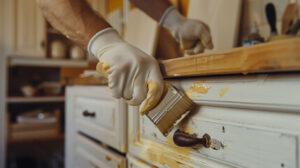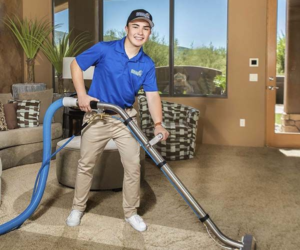Home » Articles posted by Elaine Schmidt
Author Archives: Elaine Schmidt
Cabinet Refacing – Refresh Your Kitchen Without the Hassle of a Full Remodel
Cabinet refacing is perfect for those looking to revamp their kitchen without going through the expensive and time-consuming process of a complete remodel. It is also ideal for those wanting to address physical problems with their cabinets such as warped doors and scratches.

It is also a greener alternative to complete replacement, since it utilizes the current cabinet structure while adding new doors and drawer fronts. Contact Cabinet Refacing Sacramento for professional help.
Cabinet refacing is a great option if you are happy with the layout of your kitchen and simply want to make it more appealing. It costs a fraction of a full replacement and can add a significant return on your investment in terms of increased home value. Plus, because refacing is less invasive and requires fewer materials than a full kitchen remodel, it can be completed in a much shorter amount of time.
Refacing your cabinets is an eco-conscious choice because it utilizes the original cabinet boxes and saves them from landfill overflow. This is because new cabinets are often constructed of medium-density fiberboard, which contains hazardous chemicals and are difficult to recycle. Refacing also eliminates the need for the production of new material, which minimizes the use of natural resources and reduces demand for raw lumber.
The cost of refacing is relatively low compared to the total cost of a complete kitchen remodel, as cabinet doors are typically less expensive than other hardware. Moreover, refacing provides the opportunity to choose from a wide array of style and veneer options that are significantly more affordable than custom woods. This is especially true if you select an alternative such as laminate that mimics the appearance of natural wood but is more durable and easier to maintain.
If you decide to reface your cabinets with hardwood, however, the price tag will rise. This is because refacing with real hardwood is more expensive than refacing with synthetic alternatives such as particleboard or MDF.
Additionally, refacing with solid wood will require more frequent maintenance because the material is susceptible to moisture and swells in humid environments. It’s important to consider these factors when budgeting your project.
While refacing your cabinets is more cost-efficient than a complete remodel, you’ll still want to be mindful of your overall renovation costs. In addition to the initial refacing cost, you’ll need to factor in additional upgrades and expenses such as countertops, appliances, backsplashes and lighting.
One of the best ways to keep your refacing project within budget is to explore promotions and discounts offered by reputable contractors. Additionally, you can often avoid unnecessary expenses by choosing simple updates such as glass or beadboard inserts and under-cabinet lighting.
Time-Saving
Cabinet refacing allows you to make changes without the major hassle that comes with a complete kitchen remodel. This is especially helpful if your kitchen is in good structural condition and you simply want to change the aesthetic of the space. A full remodel requires tearing everything out, rearranging the layout, and replacing countertops, plumbing and electrical systems, which can be a huge disruption to your daily life.
With refacing, the only thing that is changed is the front-facing elements, which can be done in a fraction of the time. Typically, a cabinet refacing project can be completed within a week or less. This makes it easier to schedule around your daily routine and mitigates the impact on your family.
As a bonus, cabinet refacing also produces significantly less construction waste than a traditional remodel. This is because it uses the existing cabinet framework, which can be reused instead of tossing it out. According to 2024 Top Kitchen & Bath Trends, sustainability is high on homeowners’ radars, so this is one way to help reduce the amount of material that ends up in landfills.
Lastly, cabinet refacing can be much quicker than a full remodel, as there is less of a mess to deal with. If you choose to reface your cabinets, the contractor can usually install new doors and hardware in just a few days, which is less disruptive than tearing out everything, installing a new kitchen, and living with an unfinished room for weeks on end.
While refacing is the go-to option for most homeowners who need to update their kitchens, it isn’t a suitable solution for everyone. If your cabinets are old and outdated but in good shape otherwise, refacing is worth the investment because it can save you money and still give you the Pinterest-worthy kitchen of your dreams. However, if you have structural issues or a fixed layout with poor-quality materials, remodeling may be more of a necessity.
Environmentally Friendly
Cabinet refacing uses the existing cabinet boxes and removes only the outer shell, which reduces waste and helps preserve natural resources. Unlike completely replacing cabinets, which requires the manufacture of new boxes and doors with substantial amounts of wood, refacing reuses what’s already there. The process is also less disruptive to your home, taking just days to complete compared to weeks or months for a full replacement remodel.
Sustainable cabinet refacing provides a wide range of customization options, allowing you to create a personalized look with different styles, materials, and hardware. For example, you can choose from wood veneers, laminates, and thermofoil to customize the color, pattern, and texture of your cabinet door panels. You can even use reclaimed wood or salvaged materials to give your kitchen character and a sense of sustainability. Additionally, you can select from a variety of paint colors, including light shades that reflect more sunlight and make your space feel bigger.
Refacing conserves natural resources and cuts down on carbon emissions that contribute to climate change. The process also generates less waste than replacing cabinets, minimizing the amount of raw materials sent to landfills. Waste disposal generates methane, carbon dioxide, and other greenhouse gases, which contribute to ozone depletion, global warming, and habitat destruction. By reducing demand for new materials and diverting usable items from the trash, cabinet refacing is an environmentally conscious choice.
Many kitchen refacing companies offer eco-friendly cabinet materials that support sustainable forestry and manufacturing practices. For instance, you can select FSC-certified wood veneers, low-VOC finishes, and recycled hardware. You can also install energy-efficient LED lighting to lower your home’s energy consumption and save on your utility bills.
When choosing materials for your cabinet refacing project, opt for low-VOC adhesives to minimize off-gassing and promote healthier indoor air quality in your home. Many traditional glues are made with toxic chemicals, such as formaldehyde, that can off-gas and cause health problems for your family. However, refacing professionals often use water-based adhesives that are free of harmful chemicals and safer for your home and family.
Versatile
Cabinet refacing offers a wide range of design options, giving homeowners the ability to change the style, color, and material of their cabinets. This allows them to refresh their kitchens without undergoing an expensive and disruptive full renovation. It’s important to note that refacing doesn’t correct any structural issues or alter the layout of your existing cabinets. Rather, it’s a cosmetic upgrade that’s best for those who want to update their aesthetic but have no desire to change the layout of their home.
With a variety of colors and materials available, homeowners can create a look that will outlast changing interior design trends. For example, a light gray finish with a marble pattern can give a classic-looking kitchen a modern, elegant appearance. Similarly, solid wood doors can provide an element of timeless elegance. These door styles paired with modern finishes and hardware create a transitional style that appeals to a broad range of design preferences.
Moreover, refacing is an environmentally-friendly choice because it reduces the amount of new material that’s needed for a remodel. By using your existing cabinet boxes and replacing only the doors and hardware, fewer materials are required, cutting manufacturing and transportation emissions. Additionally, refacing is better for the environment than a full replacement because it saves old materials from being sent to landfills.
Another way that refacing is more environmentally friendly than a full replacement is because it eliminates the need to recycle and dispose of your old cabinet boxes, which requires significant energy and resources. Additionally, the vinyl used in refacing is a durable and eco-friendly material that uses less natural resources than solid or veneer options.
When it comes to your cabinet refacing project, you can choose from a wide variety of material and style options that will transform your kitchen into a work of art. For example, if you love the look of white but are concerned about how it will age, refacing with 3D laminate can be an excellent solution. This design option uses a natural wood grain pattern to add warmth and visual interest, and it’s easy to clean and maintain.
